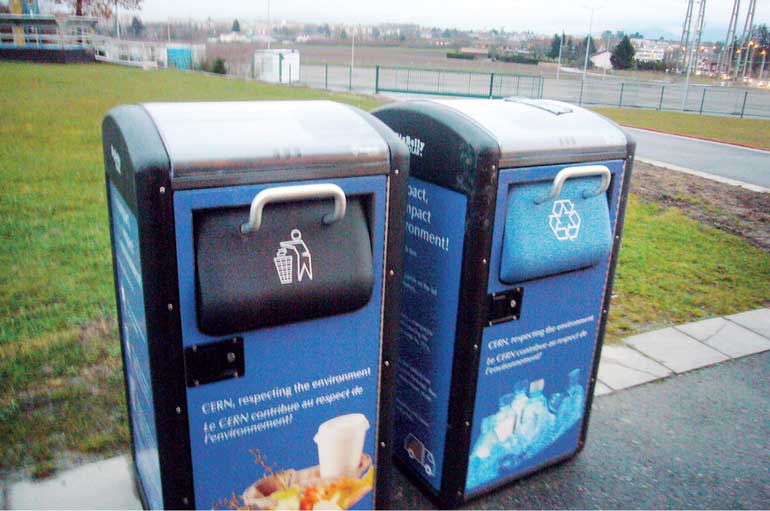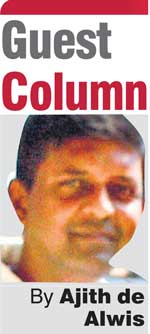Friday Jan 02, 2026
Friday Jan 02, 2026
Thursday, 18 June 2015 00:00 - - {{hitsCtrl.values.hits}}

Many of us may remember that a decade back Colombo was different and in many ways. One striking feature of Colombo was the obvious visual presence of solid waste. Street corners and by the wayside dumping of garbage was quite visual and frequent.
Even the road running parallel to the Central Environmental Authority had solid waste dumped by the wayside usually by the passing motorists who used to unload to the streets the waste that they have generated in their homes without any care.
Some forceful interventions by the CEA led to people stopping that bad practice. The issue of dengue too pointed the finger at the haphazard disposal of garbage. Subsequently Colombo started becoming a clean city and the transformation was evident to everyone.
It took effort, foresight and some diligent planning and above all execution with purpose. The garbage disappeared and streets radiated a different image. Along with unsightly dumps, posters, etc. too disappeared, there was a place for everything, and civic discipline was established.
An environmental police appeared and the rule of law was also in evidence. All were impressed and Colombo made headlines. It was always interesting to listen to the expressions of visitors from India!
Technological solutions
Generation of solid waste is synonymous with urban living. As cities evolved, it is seen from the past that what the city dwellers had done was to shift solid waste to the periphery of cities for dumping. This obviously is a poor way of waste management and as additional health-related issues surfaced with further growth, different technologies came in to manage the growing problem.
Over the years many technological pathways have appeared. In USA the Freshkills landfill on Staten Island which catered to the solid waste of New York assumed gigantic proportions and it had been stated to be visible from space along with the Great Wall of China – apparently a myth though indicating the vastness of the garbage mound!
Landfills came after the habit of dumping waste into the oceans was stopped from cities near the coastal belt. Thereafter incineration techniques were introduced. It is easy to understand the fascination with incineration. With burning at high temperatures, which is what incineration is, the mountains of waste simply disappeared.
This reduction of volume in front of one’s eyes proved to be quite appealing as incineration is still practiced and for many what is not visible is not a problem as with air pollution from air toxics. However the method has been vastly improved upon and usually energy is recovered back as either electricity or heat.
Countries with small land areas such as Singapore and Switzerland continue to use this practice of waste to energy with incineration as the prime technology. There is today however a growing body of evidence against incineration as the technology of choice. With sustainable development as the mantra for growth incineration which reduces material to ash is further frowned upon.
Colombo’s waste management process
Though Colombo had parts of the solid waste management process going well, which was evident to a majority of citizens and visitors, Colombo is yet to complete the waste management process.
The waste removed from the points of generation was simply placed in few other places. The story around those places was and continues to be different. There the story of waste and squalor continues. The last stage of the process taking place today still we have to call as dumping as even the daily soil cover that is a necessary minimum criterion is not applied.
Thus there are few dark spots within the Colombo landscape. Also the collection too is yet to reach 100% and on time. From the accepted norms of integrated solid waste management the final steps can be termed as a complete failure. The process of cleaning had elements of solid discipline by those who carried it out.
Separation at source
There is another shortcoming from the citizens and visitors. We do generate the waste yet do not significantly support the source segregation process. We are keen to place all waste irrespective of their type into one container and then look forward to get them  removed – out of sight and with the removal the issue it is out of our mind too.
removed – out of sight and with the removal the issue it is out of our mind too.
Separation at source is very important for effective management of solid waste. Some in the planning community almost believe this is an impossibility to realise from our citizens. As we religiously follow the basic rules when we are overseas this anti-social behavioural trait acceptance is not quite correct.
We need some application of rules. Few local councils have started a move in this direction forcing the community to carry out at least minimum segregation by refusing to collect the waste if mixed waste is detected. This needs to be expanded and stronger movement for segregation needs to be introduced.
Receptors in specific locations too need to be introduced for the receipt of waste. The temporary collection points had been removed at present due to the feeling that people are more likely to engage in throwing the waste towards the bin or the skip. It is true that we have seen pictures of skips with waste lying all around while the skip stays half empty!
Another point is for some civic discipline to come in. Remember we are spoiling our own city, placing our own health at risk and making someone’s work much more difficult in the process. With proper separation, recycling industry can thrive and the waste as a resource comes into reckoning. Like in Singapore the Environmental Police needs to take on a much stronger responsibility with technology back up.
In the world today see waste bins with remote communication built in which indicates when it’s full to request the collection vehicle to turn up! If we think we just should not be thinking like that, then my view is we should not think about miracles and knowledge economies for us.
Organic fraction
When all recyclables are taken into recycling, the organic fraction of the waste has to be dealt with. This is a significant fraction and the component most likely to give rise to pollution through odour, leachate and many other health issues. However, if the recyclables are removed the organic fraction too can be very well recycled.
Colombo solid waste must have received considerable attention and one can state the amount of environmental assessment reports, feasibility studies and proposals, etc., if one is to pile on top of each other the height of the stack is sure to be much more than the Kolonnawa waste dump of today! So many studies, so many discussions and so many high level meetings all have failed to deliver the final answer.
Another answer that is under discussion these days may be to remove the unsightly mess to Puttalam via the railway. That option interestingly could be one of the most expensive one way tickets ever issued to manage solid waste with really not much return, unless of course you consider money spent unwisely to take care of a growing headache as a return! The approach also breaks an environmental concept of proximity principle as one’s waste is transported to be managed elsewhere.
Final solution
It is important to identify the final solution as well. With a decent level of segregation and with a recycling infrastructure and a franchise of recycle collection centres established, the organic fraction can be tackled. A need for landfill space will not be totally out but the requirement will be quite different and easily manageable.
Today interestingly we have home composters who diligently compost the food and other green waste but burn plastic waste in the backyard. There are significant numbers who burn the whole collection by using some additional kerosene and some expect the plastics to serve as a fuel. We also have a technically designed landfill site at Dompe after many years and few countries really benefit from some of the recycled products exported out from Sri Lanka.
There is a significant need for awareness on integrated solid waste management aspects. Awareness should address the attitude towards waste too. It is known that across the country the organic fraction of the waste is more than 60% and can even reach 80%. This considerable fraction with its inherent moisture content is suited for the anaerobic digestion process which yields biogas and a biofertiliser (soil conditioner).
Biogas is without doubt a more versatile renewable energy source due to its determinate energy value and ease of storage, hence, potential utilisation is independent of factors such as geographical location and season – a factor that most renewable fail on. It can be used directly for heating and electricity generation, and as substitute for fossil fuel applications, e.g., transport fuel.
The potential utilisation of the digestate as fertiliser can also reduce dependence on energy intensive mineral fertilisers. With about 700 and more tons of waste per day there is the potential to generate around 4 MW electricity or generate transport fuel. CEB may frown on just 4 MWe but the salient fact that planners fail to realise is that the waste get managed, energy gets generated and a fertiliser is produced. Can anyone come forward with a technology scheme to challenge such an opportunity?
The point to ponder is, with such an opportunity present, why we have contemplated everything other than this? The recommendation to the problem facing Colombo is indicated and I will follow up this with an explanation to justify ‘for Colombo and in Colombo’ in my next column.
[The writer is Professor of Chemical and Process Engineering at the University of Moratuwa, Sri Lanka. With an initial BSc Chemical engineering Honours degree from Moratuwa, he proceeded to the University of Cambridge for his PhD. He is the Project Director of COSTI (Coordinating Secretariat for Science, Technology and Innovation), which is a newly established State entity with the mandate of coordinating and monitoring scientific affairs. He can be reached via email on [email protected].]